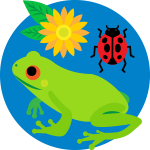The Ways of the Shaman
Tropical forests of the world are home to an estimated 1,000 different native tribes. People who live in remote places depend on the plants and animals that live around them for food and medicine. In many of these tribes, men and women known as "shamans" are the village experts who have learned how to use plants for medical purposes. Becoming a shaman requires many years of study, which explains why most shamans are elderly. Today, ethnobotanists (scientists who study how different cultures make use of native plants) are working much more with shaman healers and Western medical doctors to scientifically test and identify plants that can help treat specific diseases. Many modern medicines that we use today come from remedies used by shamans thousands of years ago.
Scientific name: Catharanthus roseus
Size: one foot tall
Habitat: forests of Madagascar
Characteristics: shiny green leaves, a small pinkish flower
Significance: contains chemicals called vincristine and vinblastine, which help people with Hodgkin's disease and childhood leukemia (both are forms of cancer)
Scientists who study how traditional cultures use plants in everyday life are called:
botanists
plantologists
ethnobotanists
Correct!
Ancient cultures have been using plants to treat illnesses for thousands of years. Ethnobotanists study the ways that different cultures use plants for medicine, nutrition, and clothing.
What percent of health problems are treated with plant- and animal-based medicines?
2 percent
40 percent
90 percent
Correct!
Almost half of all medicine comes from plants and animals! That's one reason why it's so important to protect habitats where plants like the rosy periwinkle grow.
To fight cancer and other illnesses, doctors often tell patients to eat the leaves right off rosy periwinkle plants.
Fiction
The leaves of the rosy periwinkle contain deadly chemicals. Scientists change the chemicals in the rosy periwinkle to create medicines.
Rosy periwinkles are found in Madagascar's tropical forests. If the forests continue to be destroyed, they could be gone in 25 years.
Fact
The more we cut down tropical forests, the quicker we may lose valuable plants, like the rosy periwinkle, that scientists haven't even identified yet.




 Biodiversity
Biodiversity
 Brain
Brain
 Genetics
Genetics
 Marine BiOLogy
Marine BiOLogy
 MicrobiOLogy
MicrobiOLogy
 PaleontOLogy
PaleontOLogy
 ZoOLogy
ZoOLogy
 AnthropOLogy
AnthropOLogy
 ArchaeOLogy
ArchaeOLogy
 Astronomy
Astronomy
 Climate Change
Climate Change
 Earth
Earth
 Physics
Physics
 Water
Water
